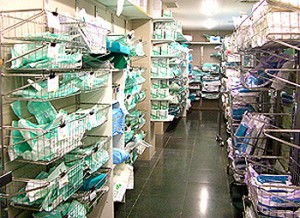 Working closely with local staff and leadership in St. Joan de Deu, Kairos Management has recently finished improvement of the supply chain of children’s’ surgical services, significantly reducing stock and space used by 30%, as well as helping to enable on-time starts. This initiates Kairos’ engagement in the health sector as a key future area of interest for the company.
Working closely with local staff and leadership in St. Joan de Deu, Kairos Management has recently finished improvement of the supply chain of children’s’ surgical services, significantly reducing stock and space used by 30%, as well as helping to enable on-time starts. This initiates Kairos’ engagement in the health sector as a key future area of interest for the company.
Improving on-time starts
The project originally grew out of the hospital’s effort to improve on-time starts, the punctuality with which the first surgery of the day begins; a strongly monitored indicator in the industry. Analyzing the reasons for delays it soon became clear that some delays were attributable to supply chain problems in the supply of surgical material. Having made some initial experiences with Kanban systems on their own in a small part of their supply chain, the Hospital’s chief of children’s operating room (OR), Dr. Banchs decided to contact Kairos Management for an outside point of view and Lean Six Sigma expertise.
After the introductory visit and observations, it became indeed apparent that a Kanban system could significantly improve performance of the supply chain for the operating room in terms of inventory on hand, availability of items, space used, and time spent managing the system. Kairos then developed an implementation plan based on the DMAIC structure of Lean/Sigma and together with Dr. Banchs planned the detailed involvement of local surgical staff and the hospital’s purchasing team to form an integrated multi-disciplinary project team.
Getting the quantities right
The crucial part of any Kanban system is getting the quantities right. The project team therefore decided to take a hybrid approach. First, the monthly supply chain data of the previous year was used to statistically analyse the average daily need and its monthly variation, then the calculated quantities of the more than 1000 products were checked and discussed by the local surgical staff to guarantee availability of products also during sudden demand surges, a concern that is especially important in the health care industry. In addition, the weekly OR plan was screened and slightly adapted and consequently the ideal locations of the products were determined based on their use in the ORs.
For implementation, the traditionally quiet December/January period was chosen to minimize the interruption of work. It went in various stages, starting with the central supply room and ending with the in-OR anesthesia carts. After a 1-2 month settling period the results are savings for items on hand (value and number), and space used around 30%. What’s more though,is that highly trained local surgical staff has been significantly freed up to do their surgical support work rather than managing the supply chain system.
The Lean Six Sigma bug
And the hospital has the ‘Lean Six Sigma bug’ now: With the more detailed supply chain data that became available through the implementation of the kanban system, Dr. Banchs is certain that a second round of reductions on the kanban quantities will allow for even more savings. The hospital has also decided to go start its journey on the lean/sigma road and train some internal specialists in Lean Six Sigma.
In retrospect Dr. Banchs says: ‘What surprised me in this project was that the hardest part wasn’t coming up with good solutions, it was taking all the people with us in the process’. This is the power of Lean Six Sigma.



